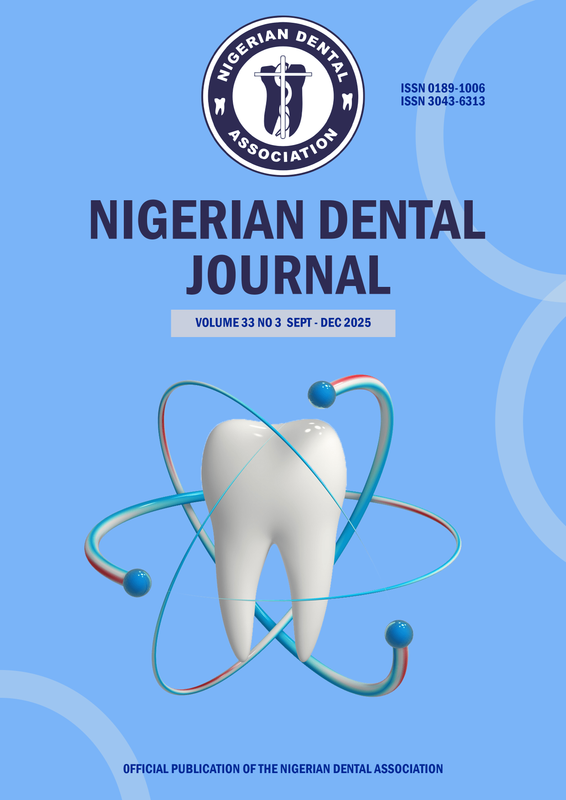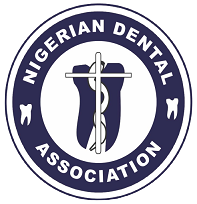ORAL MALODOUR: AN INDICATOR OF ORAL NEGLECT AND POOR SELF-ESTEEM AMONG SLUM DWELLING CHILDREN IN NIGERIA
ORAL MALODOUR: AN INDICATOR OF ORAL NEGLECT AND POOR SELF-ESTEEM
DOI:
https://doi.org/10.61172/ndj.v32i2.283Keywords:
quality of life., self-esteem,, oral health, oral malodor, halitosisAbstract
Objective: Oral malodour, an inadequately studied disease in children, is the third most prevalent reason for dental consultations, with negative impacts on psychosocial health. This study assessed self-rated and normatively assessed oral malodour and its impact on quality of life among a cohort of slum dwelling children in Lagos, Nigeria.
Method: This descriptive survey was conducted among slum dwelling children in Lagos State, Nigeria. A multi-stage sampling method was utilized to select participants for the study. The Organoleptic test was utilized by two calibrated dentists to assess oral malodour. The Self-Reported Scale for Oral Health (SOHO) and the Rosenberg Self-Esteem Scale (RSE) were used to assess quality of life and self-esteem. Regression analysis was done using sociodemographic, clinical, self-esteem and QOL variables as the predictor variables to identify their strength of association with oral malodour. The probability level of p<0.05 was considered significant.
Results: Majority of the 427 respondents were aged between 10-14 years of age (67%), and were females (54.4%). Thirty four percent of the respondents self-rated themselves as having oral malodour; Normatively, 22.6% of the respondents had oral malodour. There was a significant association between OHRQOL (aOR: 2.724; CI: 1.563-4.932), gingival inflammation (aOR: 2.402; CI: 1.417-4.078), self-esteem (aOR: 2.546; CI :2.015-5.246), self-rated oral malodour (aOR: 3.846; CI: 2.118-8.571), parental education (aOR: 1.483; CI: 1.034-1.940), history of dental visit (aOR: 8.375; CI: 2.435-28.810), reason for dental visit (aOR: 2.224; CI: 0.932-5.310), and number of children in in the family (aOR: 1.106; CI: 1.010-1.212), with oral malodour.
Conclusion: Oral malodour was significantly associated with low self-esteem, poor OHRQOL poor oral health and dental attendance pattern. The oral health of slum dwelling children needs to be seen by policymakers as an important predictor of their mental health and wellbeing.
Downloads
References
REFERENCES
Loesche, W. The effects of antimicrobial mouth rinses on oral malodour and their
status relative to use Food and Drug Administration regulations. Quintessence Int. 1999; 30, 311-18.
Song Y, Ahn YB, Shin MS, Brennan D, Kim HD. Association of periodontitis with oral malodor in Korean adults. PLoS One. 2021 Mar 4;16(3):e0247947. doi: 10.1371/journal.pone.0247947
King TL. Bad breath and school bullying. Dentistry for children. 2019. Available at:
http://pediatricdentistorlando.com/bad-breath-school-bullying/. Accessed: 21 Mar 2020
Aylıkcı BU, Colak H. Halitosis: From diagnosis to management. J Nat Sci Biol Med. 2013 Jan;4(1):14-23. doi: 10.4103/0976-9668.107255.
Porter SR, Scully C. Oral malodour (halitosis). BMJ. 2006;333 (7569):632–635.
doi:10.1136/bmj.38954.631968.AE
Bicak DA. A current approach to halitosis and oral malodor- a mini review. Open Dent
J. 2018;12(1):322–330. doi:10.2174/ 1874210601812010322
Kanehira, T., Takehara, J., Takahashi, D., Honda, O. & Morita, M. Prevalence of
oral malodor and the relationship with habitual mouth breathing in children. J Clin Pediatr Dent. 2004; 4, 285-8.
Villa, A., Zollanvari, A., Alterovitz, G., Cagetti, M., Strohmenger, L., Abati, S., 2014.
Prevalence of halitosis in children considering oral hygiene, gender and age. Int. J. Dent.
Hyg. 12, 208–212. https://doi. org/10.1111/idh.12077.
Ueno, M., Ohnuki, M., Zaitsu, T., Takehara, S., Furukawa, S., Kawaguchi, Y., 2018.
Prevalence and risk factors of halitosis in Japanese school children. Pediatr. Int. 60, 588–592. https://doi.org/ 10.1111/ped.13561
Machado NAdG, Strini PJSA, Carneiro MOP, Júnior RB, Neto AJF. Halitosis: a
review of basic principles. 2009.
Hughes FJ, McNab R (2008) Oral malodour-a review. Arch Oral Biol 53: 1-7
Azodo, C.; Osazuwa-Peters, N.; Omili, M. Psychological and social impacts of
halitosis: A review. J. Soc. Psychol. Sci. 2010, 3, 74–92.
Rusthen S, Young A, Herlofson BB, Aqrawi LA, Rykke M, Hove LH, et al. Oral disorders, saliva secretion, and oral health-related quality of life in patients with primary Sjögren's syndrome. Eur J Oral Sci. 2017;125(4):265–271.
Olatosi OO, Oyapero A, Ashaolu JF, Abe A, Boyede GO. Dental caries and oral health: an ignored health barrier to learning in Nigerian slums: a cross sectional survey. PAMJ-One Health. 2022 Jan; 7(13). doi: 10.11604/pamj-oh.2022.7.13.27641
Ferdous F., Das S., Ahmed S., Farzana F., Malek M., Das J.et al.. Diarrhoea in slum children: observation from a large diarrhoeal disease hospital in dhaka, bangladesh. Tropical Medicine & International Health 2014;19(10):1170-1176. https://doi.org/10.1111/tmi.12357
Gazi M., Alam M., Fahim S., Wahid B., Khan S., Islam M.et al.. Infection with escherichia coli pathotypes is associated with biomarkers of gut enteropathy and nutritional status among malnourished children in bangladesh. Frontiers in Cellular and Infection Microbiology 2022;12. https://doi.org/10.3389/fcimb.2022.901324
Sabde YD, Trushna T, Mandal UK, Yadav V, Sarma DK, Aher SB, Singh S, Tiwari RR, Diwan V. Evaluation of health impacts of the improved housing conditions on under-five children in the socioeconomically underprivileged families in central India: A 1-year follow-up study protocol. Front Public Health. 2022 Sep 6;10:973721. doi: 10.3389/fpubh.2022.973721.
Loesche WJ, Kazor C. Microbiology and treatment of halitosis. Periodontol 2000. 2002;28:256-79. doi: 10.1034/j.1600-0757.2002.280111.x.
Umeizudike KA, Oyetola OE, Ayanbadejo PO, Alade GO, Ameh PO. Prevalence of self reported halitosis and associated factors among dental patients attending a tertiary hospital in Nigeria. Sahel Med J 2016;19:150-4
Cassolato, SF, Turnbull, RS. Xerostomia: Clinical aspects and treatment. Gerodontal. 2013;20: 64-77
Alade O, Ajoloko E, Dedeke A, Uti O, Sofola O. Self-reported halitosis and oral
health related quality of life in adolescent students from a suburban community in Nigeria. Afri Health Sci. 2020;20(4):2044-9. https://dx.doi.org/10.4314/ahs.v20i4.62
Lu H-X, Tang C, Chen X, Wong MCM, Ye W. Characteristics of patients
complaining of halitosis and factors associated with halitosis. Oral Dis. 2014;20(8):787–
doi:10.1111/odi.12198
Quirynen M, Dadamio J, Van den Velde S, et al. Characteristics of 2000 patients who
visited a halitosis clinic. J Clin Periodontol. 2009;36(11):970–975. doi:10.1111/j.1600-
X.2009.01478.x
Briceag R, Caraiane A, Raftu G, Horhat RM, Bogdan I, Fericean RM, Shaaban L, Popa M, Bumbu BA, Bratu ML, et al. Emotional and Social Impact of Halitosis on Adolescents and Young Adults: A Systematic Review. Medicina. 2023; 59(3):564. https://doi.org/10.3390/medicina59030564
Silva MF, Leite FRM, Ferreira LB, et al. Estimated prevalence of halitosis: a
systematic review and meta-regression analysis. Clin Oral Investig. 2018;22(1):47–55.
doi:10.1007/s00784-017-2164-5
Silva MF, Leite FRM, Ferreira LB, Pola NM, Scannapieco FA, Demarco FF, Nascimento GG. Estimated prevalence of halitosis: a systematic review and meta-regression analysis. Clin Oral Investig. 2018 Jan;22(1):47-55. doi: 10.1007/s00784-017-2164-5.
Rösing CK, Loesche W. Halitosis: an overview of epidemiology, etiology and clinical
management. Braz Oral Res. 2011;25(5):466–471. doi:10.1590/S1806-
Nazir M., Al-Ansari A., Abbasi N., & Almas K.. Global prevalence of tobacco use in adolescents and its adverse oral health consequences. Open Access Macedonian Journal of Medical Sciences 2019;7(21):3659-3666. https://doi.org/10.3889/oamjms.2019.542
Loesche WJ, Kazor C. Microbiology and treatment of halitosis. Periodontol 2000. 2002;28:256-79. doi: 10.1034/j.1600-0757.2002.280111.x.
Nazir MA. Prevalence of periodontal disease, its association with systemic diseases and prevention. Int J Health Sci (Qassim). 2017 Apr-Jun;11(2):72-80. PMID: 28539867; PMCID: PMC5426403.
Patel J, Kulkarni S, Doshi D, Reddy P, Reddy S, Srilatha A. Association Between Social Anxiety with Oral Hygiene Status and Tongue Coating among Patients with Subjective Halitosis. J Dent Hyg. 2017 Oct;91(5):55-63. PMID: 29118280.
Hannan MA, Chowdhury MT, Khan MA, Chowdhury AF, Shahidullah KM, Saha AK, Anjum A. Prevalence of Gingivitis, Plaque accumulation and Decayed, Missing and Filled Teeth among slum population in Bangladesh. Bangladesh Med Res Counc Bull. 2014 Aug;40(2):47-51. doi: 10.3329/bmrcb.v40i2.25182. PMID: 26415339.
de Jongh A, van Wijk AJ, Horstman M, de Baat C. Attitudes towards individuals with
halitosis: an online cross sectional survey of the Dutch general population. Br Dent J.
;21(4):E8. doi:10.1038/sj. bdj.2014.101
McKeown L. Social relations and breath odour. Int J Dent Hyg 2003; 1: 213–217
Vali, A.; Roohafza, H.; Hassanzadeh Keshteli, A.; Afghari, P.; Javad Shirani, M.;
Afshar, H.; Savabi, O.; Adibi, P. Relationship between subjective halitosis and
psychological factors. Int. Dent. J. 2015, 65, 120–126. [CrossRef]
ADA Council on Scientific Affairs: Oral malodor. Journal of the American Dental
Association 2003, 134:209-14
Downloads
Published
Issue
Section
License
Copyright (c) 2024 Afolabi Oyapero , Moyosoore Osoba, Samson Kareem, Sydon Agbor

This work is licensed under a Creative Commons Attribution 4.0 International License.
Open Access Statement
- We became fully Open Access since January 2023.
- Our new and archived materials are available free of charge on open basis and under a Creative Commons license as stated below.
Copyright statement
Copyright © 1999 The authors. This work, Nigerian Dental Journal by Nigerian Dental Association is licensed under Creative Commons Attribution 4.0 International License.


